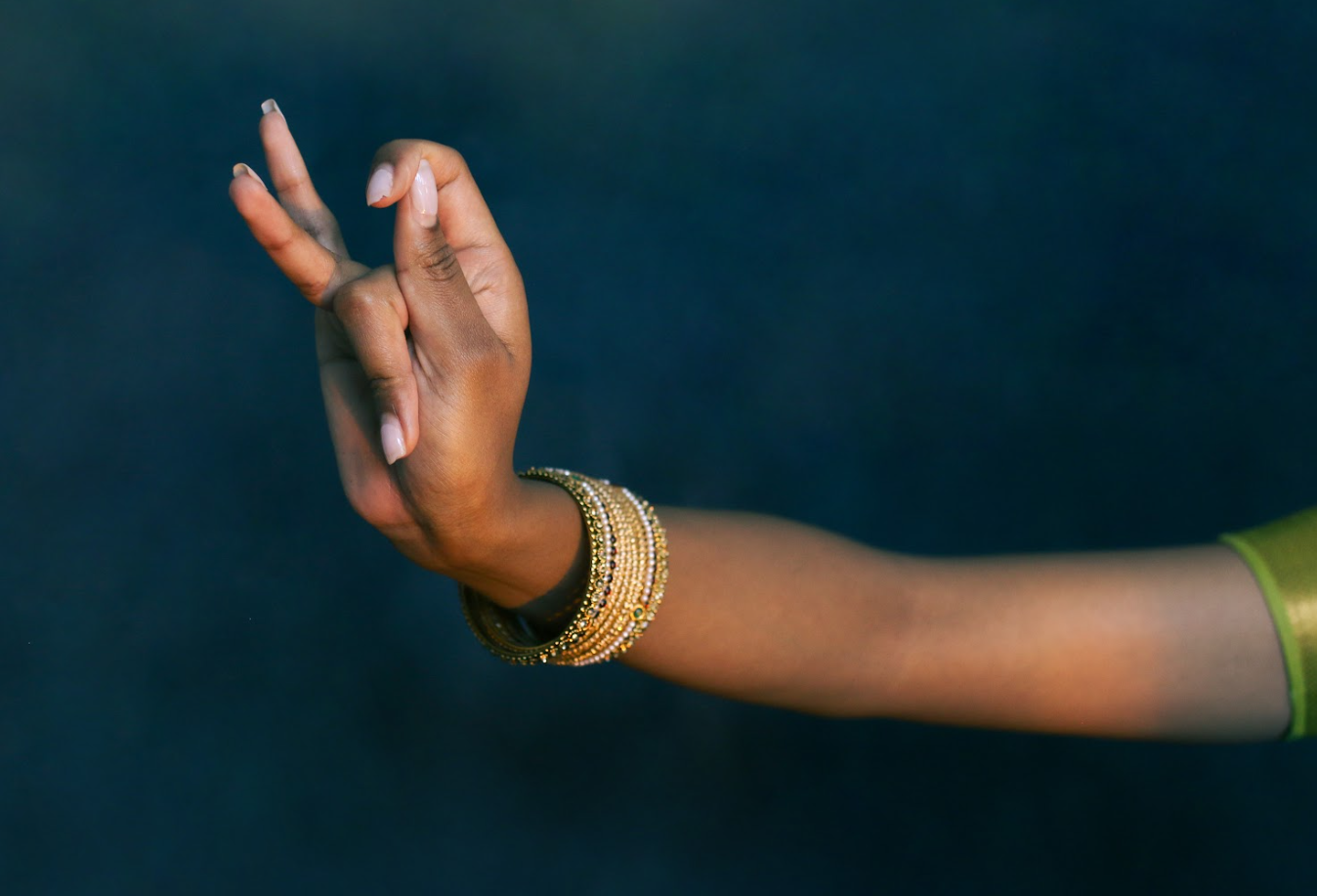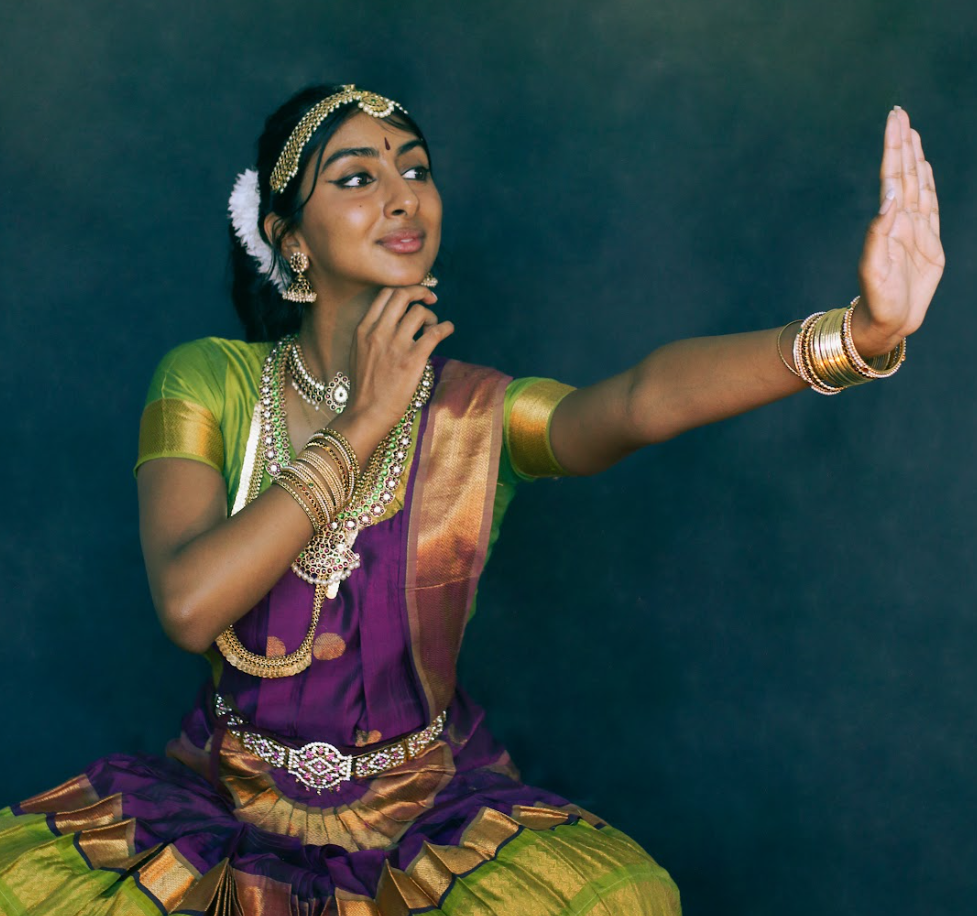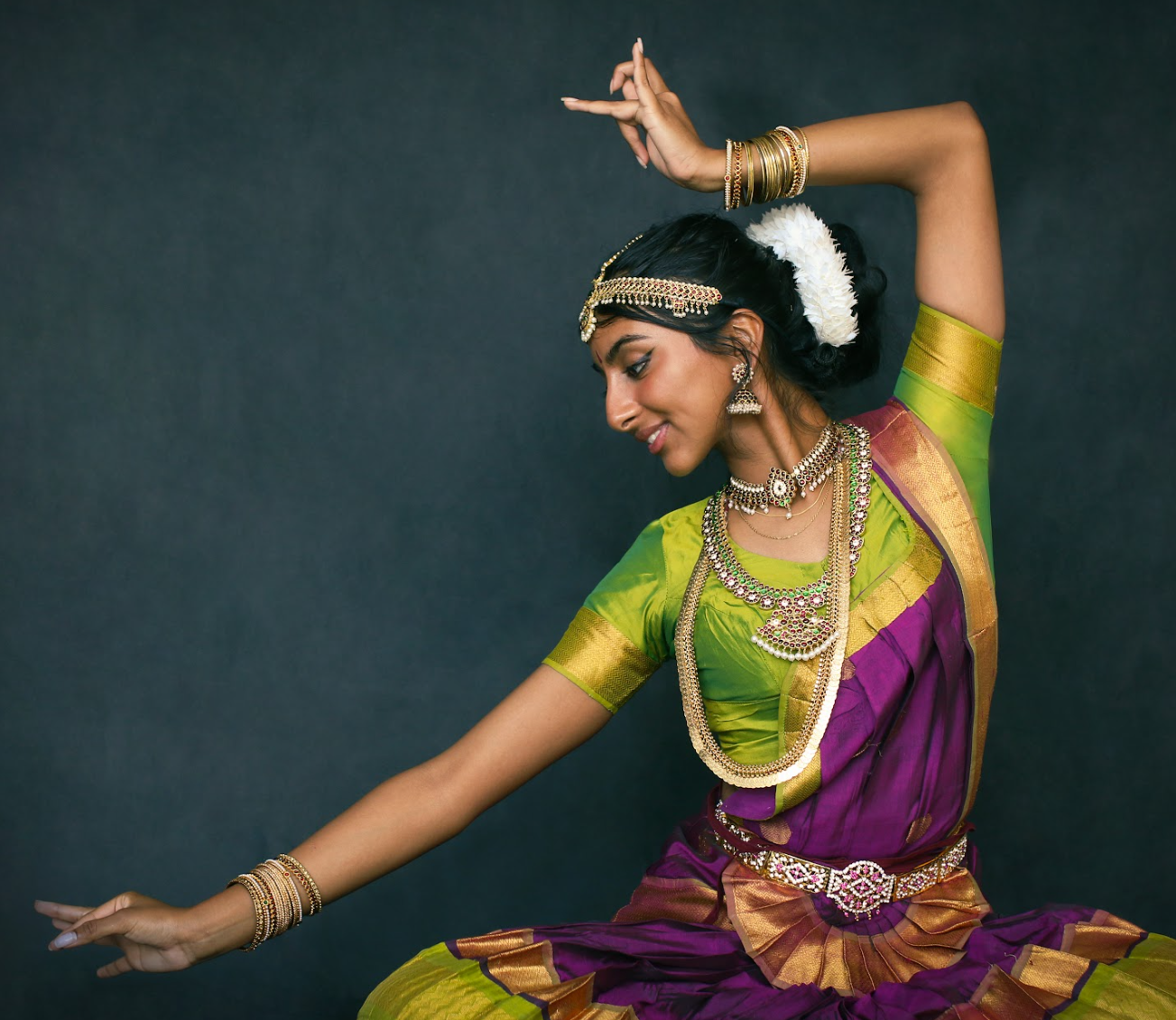The hands that speak
My fascination lay in the transformation of something otherwise unremarkable: a pedestrian curve of the wrist turned her hands into blooming lotuses; a careful bend of her fingers turned her hands into birds.
Image Credit: Nishta Gupta
Photographer: Nishta Gupta
Talent: Prithi Ashok
On a summer night in the mid 2010s, a dancer spins onto a stage. A hurricane of red silk surrounds her. Her coy gaze pans across the audience, bewitching us all with the whiplash of her irises. Language becomes obsolete in a moment like this. The power of the written word is a suspended belief when the human body surpasses its capacity to tell stories.
It was not her face that enraptured me, not her theatrical makeup, nor the tinkling bells that shook above her ankles. It was the hands that carved tales of gods and sacrifice from air. Parts of her fingers were stained a terracotta red, accompanied by a blazing circle of that same colour in the centre of her palms. My fascination lay in the transformation of something otherwise unremarkable: a pedestrian curve of the wrist turned her hands into blooming lotuses; a careful bend of her fingers turned her hands into birds. Such is the artistry embedded within Bharatantyam.
Figure 1. Alapadma, often used to symbolise a fully-bloomed lotus. When combined with other movements, it may represent picking fruit or the splashes of falling rain.
Mudras — intricate hand gestures used by Bharatanatyam dancers — are the soul of classical Indian dance. They are the linguistic apparatus used to convey human expression and symbolic meaning through the dancer’s hands. In the way a magician might wield a sleight of hand for the dramatics, Bharatanatyam dancers wield their hands’ kinetic faculties to connect the realm of the abstract with the dizzying spectacle of performance.
Figure 2. A kataka mukha mudra which may represent a bird or woman.
Several ancient texts preside over the art of classical Indian dance. The Natyasatra Bharata (200BCE - 200CE) is often cited as the genesis of performance studies in India. It lists sixty-six mudras, twenty-four of which are single-handed — named ‘asamyukta’ — and thirteen of which utilise both hands — named ‘samyukta’.
The hands have a uniquely omniscient role, which curiously contrasts with the semiotics of Western dance. In Bharatanatyam, the hands themselves have eyes: they perceive things, they are the principle narrators of a story, they are eerily self-aware and are able to interpret meaning through movement. They act as their own entities. This is in contrast to Western ballet which inscribes the entire body as the impetus of narrative. Through Western dance forms, we are all familiar with the configurations of human expression and how the skeletal frame tells stories. The pinpointed literature of mudras, in contrast, prescribes primary storytelling to the fingers, palms, and wrists.
Mudras have multiple meanings, similarly to homonyms, and it is partly the multifaceted nature of performance that makes Bharatanatyam exquisitely impactful. Take the pataka: the fingers are upright, tightly pressed together without gaps. Depending on context, it may depict an act of blessing, or more organic forces such as the air, sky, or water. The triptaka is similar to the pataka, however the ring finger is folded. This symbol may portray the king and regalia, whilst also potentially portraying a bindi, or the act of drawing a line.
Figure 3. A pataka is used to signify a mirror.
Figure 4. A hamsasya mudra is used by both hands to represent putting on an anklet.
Figure 5. A pataka mudra is used in conjunction with a repeated, sweeping alapadma (left hand) to symbolise abundance or giving.
A specific subset of Bharatanatyam dances translates myths, religious parables, and folklore into physicalised images. ‘The Clothes of Draupadi’, for example, is a popular tale from the Hindu epic, Mahabharata, that has been ossified into dance. The tale follows Draupadi, the consort of the five Pandava brothers, who was staked as a bet during a dice game between the brothers and their antagonists, Shakuni and Duryodhana. After Shakuni wins the round of dice, Draupadi is brought to Duryodhana as a slave, and in an attempt to humiliate her before the court, Duryodhana’s younger brother, Dhushasana, attempts to disrobe Draupadi. Draupadi prays to Krishna for protection, and through his divine intervention, Dushasana is unable to disrobe her as the fabric of her sari never lessens:
Figure 6. This hand placement depicts garments and clothing. When directly following the mudras in Figure 5, the dancer can articulate Draupadi’s endless sari.
“Hearing the words of Draupadi, Krishna was deeply moved…the illustrious Dharma, remaining unseen, covered her with excellent clothes of many hues. And, O monarch as the attire of Draupadi was being dragged, after one was taken off, another of the same kind, appeared covering her. And thus did it continue till many clothes were seen…hundreds upon hundreds of robes of many hues came off Draupadi's person.”
Bharatanatyam rejects the use of instruments seen in other forms of narrative dance and drama such as props, stage sets, and costumes. Instead, the Bharatanatyam dancer uses their body to illustrate multiple characters and environments, oftentimes simultaneously. Thus, the language of the dance form is inherently complex and polyphonic, though liberal. For a dancer to successfully communicate a narrative, they must exhibit a profound understanding of spirituality:
“[their] body acts as a vehicle to salvation… But there is an inner and subtle quality that creates the fundamental difference between the expert and the artist. This quality is to achieve the technique and forget it. A truly spiritual artist is one who forgets himself and in that forgetfulness achieves the bliss which is called Ananda.”
Within this ‘bliss’, the observer must understand the conceptual journey being presented. An ideal journey is the product of contrivances ranging from the rhetorical permutations of hands to fanciful facial expressions, all of which replicate the impact of well-paced dialogue or vivid imagery in a novel.
The dramatis personae of a Bharatanatyam performance is extensive. There are the hands, the feet, the eyes, the dress. There is also the spiritual: the things we do not see, but rather experience. Bharatanatyam seeks to comprehend the incomprehensible, to decode the inscriptions of the divine. The ‘bliss’ is shared between the dancer and observer in a communion with the gods as the heavens descend to earth through dance.
Figure 7. The suchi (lower hand) and mukula (upper hand) mudras are used to portray Ganesha’s tusks and trunk.
Figure 8. The kataka mukha mudra (top hand) and hamsaya mudra (bottom hand) used to show the Ganges River flowing from Shiva’s head.









